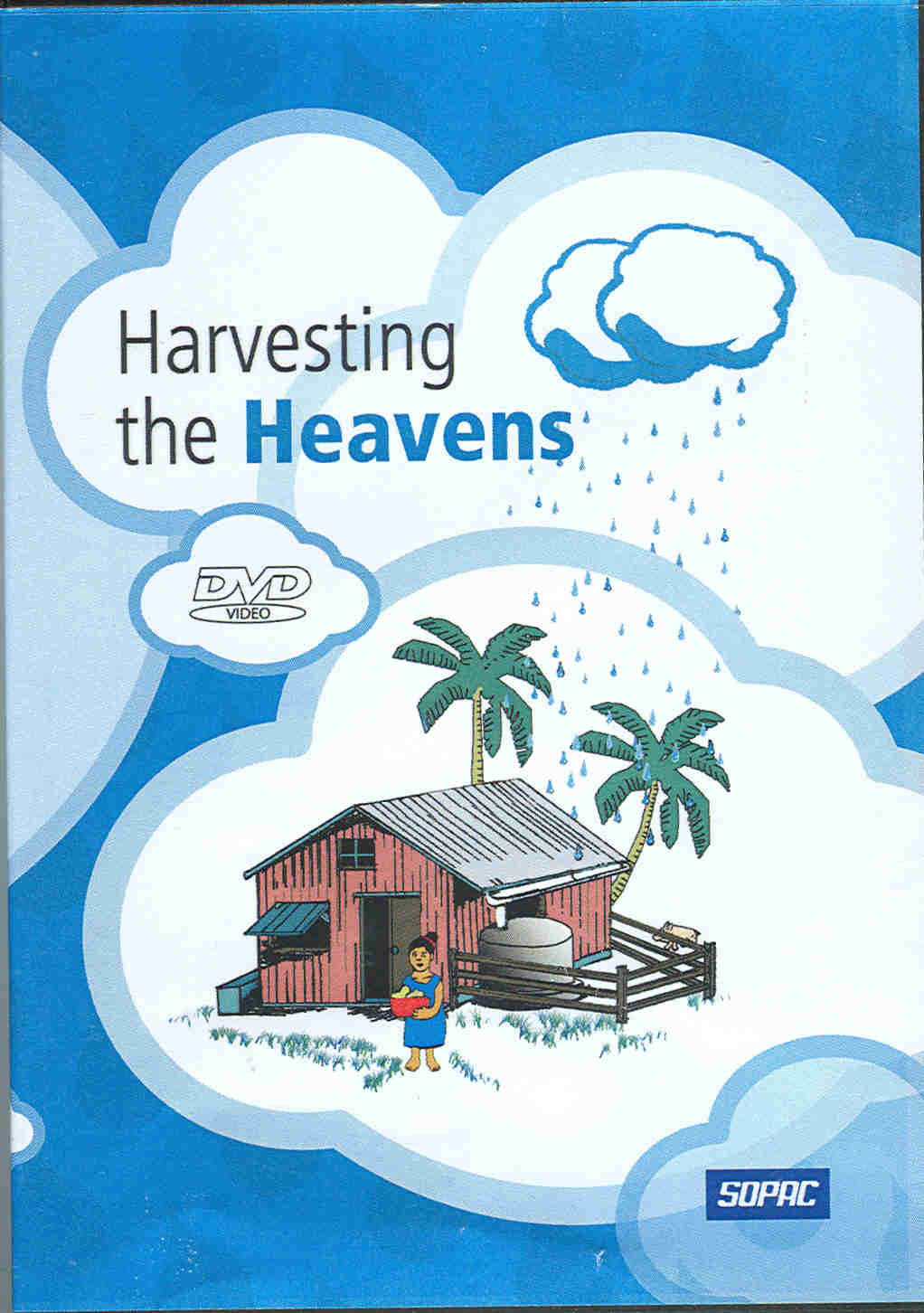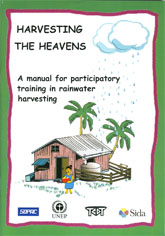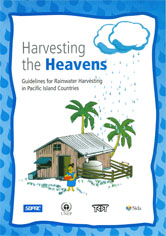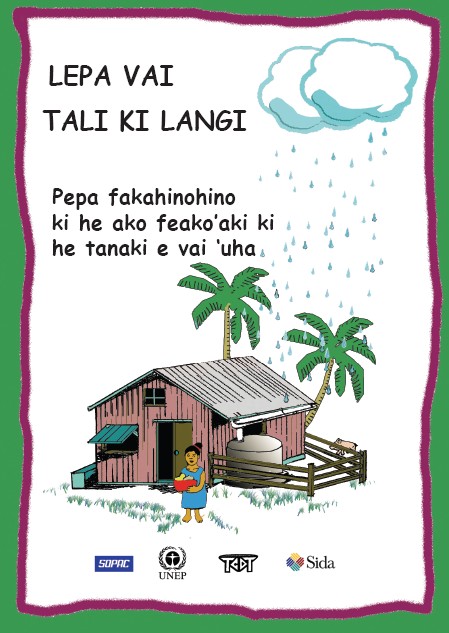Rainwater Harvesting
Rainwater harvesting has not generally been given the attention it deserves. It has often been looked upon as a technology of last resort, to be used only when no other alternatives exist, such as on some of the Pacific low-lying islands lacking fresh surface water or groundwater. However, even when alternative supplies do exist, rainwater can provide a useful supplementary supply and important backup when the main supply breaks down, dries up or becomes saline during droughts. Through the use of rainwater harvesting the demand on existing water resources can be reduced.
Rainfall generally occurs everywhere in the Pacific in abundant quantity. Since most people live in houses with roofs they already have a catchment surface from which rainwater runoff can be collected. Add guttering and a tank and householders are ready to "harvest the heavens".
SOPAC's most recent involvement in rainwater harvesting in the region has been with a United Nations Environment Programme (UNEP) pilot project carried out in Vava'u, Tonga through the Ama Takiloa programme of the Tonga Community Development Trust (TCDT). The project was part of a UNEP initiative to promote rainwater harvesting both in Africa and the Pacific region. Apart from the construction of rainwater harvesting infrastructure in two villages, there are 3 main outputs from the project which aim to capture the lessons learned and so provide useful tools for others promoting and carrying out rainwater harvesting projects. These are:
 A DVD documentary which follows the pilot project in Vava'u. The video highlights important aspects of the project including community participation and ownership, encouraging women as well as men to participate in water management and promoting sustainable approaches.
A DVD documentary which follows the pilot project in Vava'u. The video highlights important aspects of the project including community participation and ownership, encouraging women as well as men to participate in water management and promoting sustainable approaches.
 A manual for participatory training in rainwater harvesting. The manual was developed to complement a "Training of Trainers" workshop that was conducted as part of the project. It is targeted for use by NGOs, CBOs or others involved in rainwater harvesting and contains a number of participatory techniques, tools and activities to assist communities in learning about the operation and maintenance of rainwater harvesting systems.
A manual for participatory training in rainwater harvesting. The manual was developed to complement a "Training of Trainers" workshop that was conducted as part of the project. It is targeted for use by NGOs, CBOs or others involved in rainwater harvesting and contains a number of participatory techniques, tools and activities to assist communities in learning about the operation and maintenance of rainwater harvesting systems.
 Guidelines for Rainwater Harvesting in Pacific Island Countries. The guidelines are for people who are interested in building or maintaining a rainwater harvesting system. It is also for NGOs, CBOs, regional organisations and donor agencies that are involved in the implementation of rainwater harvesting projects. The intention of the guidelines is to help in the sustainable implementation of rainwater harvesting projects as well as to assist in improving the quality of the water supply. It contains both technical design, operation and maintenance information as well as discussing approaches to project implementation and sustainability.
Guidelines for Rainwater Harvesting in Pacific Island Countries. The guidelines are for people who are interested in building or maintaining a rainwater harvesting system. It is also for NGOs, CBOs, regional organisations and donor agencies that are involved in the implementation of rainwater harvesting projects. The intention of the guidelines is to help in the sustainable implementation of rainwater harvesting projects as well as to assist in improving the quality of the water supply. It contains both technical design, operation and maintenance information as well as discussing approaches to project implementation and sustainability.
 Tongan version of the Harvesting the Heavens manual.
Tongan version of the Harvesting the Heavens manual.
The Guidelines and Manual can be downloaded by clicking on the front cover icons above.
Hard copies and copies of the DVD are available through the SOPAC secretariat.
Rainfall generally occurs everywhere in the Pacific in abundant quantity. Since most people live in houses with roofs they already have a catchment surface from which rainwater runoff can be collected. Add guttering and a tank and householders are ready to "harvest the heavens".
SOPAC's most recent involvement in rainwater harvesting in the region has been with a United Nations Environment Programme (UNEP) pilot project carried out in Vava'u, Tonga through the Ama Takiloa programme of the Tonga Community Development Trust (TCDT). The project was part of a UNEP initiative to promote rainwater harvesting both in Africa and the Pacific region. Apart from the construction of rainwater harvesting infrastructure in two villages, there are 3 main outputs from the project which aim to capture the lessons learned and so provide useful tools for others promoting and carrying out rainwater harvesting projects. These are:
 A DVD documentary which follows the pilot project in Vava'u. The video highlights important aspects of the project including community participation and ownership, encouraging women as well as men to participate in water management and promoting sustainable approaches.
A DVD documentary which follows the pilot project in Vava'u. The video highlights important aspects of the project including community participation and ownership, encouraging women as well as men to participate in water management and promoting sustainable approaches. A manual for participatory training in rainwater harvesting. The manual was developed to complement a "Training of Trainers" workshop that was conducted as part of the project. It is targeted for use by NGOs, CBOs or others involved in rainwater harvesting and contains a number of participatory techniques, tools and activities to assist communities in learning about the operation and maintenance of rainwater harvesting systems.
A manual for participatory training in rainwater harvesting. The manual was developed to complement a "Training of Trainers" workshop that was conducted as part of the project. It is targeted for use by NGOs, CBOs or others involved in rainwater harvesting and contains a number of participatory techniques, tools and activities to assist communities in learning about the operation and maintenance of rainwater harvesting systems. Guidelines for Rainwater Harvesting in Pacific Island Countries. The guidelines are for people who are interested in building or maintaining a rainwater harvesting system. It is also for NGOs, CBOs, regional organisations and donor agencies that are involved in the implementation of rainwater harvesting projects. The intention of the guidelines is to help in the sustainable implementation of rainwater harvesting projects as well as to assist in improving the quality of the water supply. It contains both technical design, operation and maintenance information as well as discussing approaches to project implementation and sustainability.
Guidelines for Rainwater Harvesting in Pacific Island Countries. The guidelines are for people who are interested in building or maintaining a rainwater harvesting system. It is also for NGOs, CBOs, regional organisations and donor agencies that are involved in the implementation of rainwater harvesting projects. The intention of the guidelines is to help in the sustainable implementation of rainwater harvesting projects as well as to assist in improving the quality of the water supply. It contains both technical design, operation and maintenance information as well as discussing approaches to project implementation and sustainability. Tongan version of the Harvesting the Heavens manual.
Tongan version of the Harvesting the Heavens manual. The Guidelines and Manual can be downloaded by clicking on the front cover icons above.
















